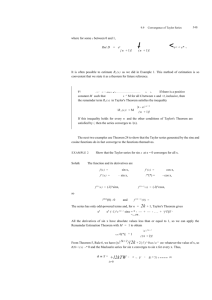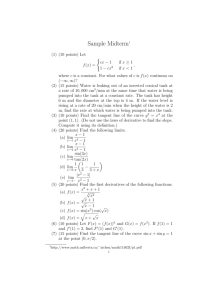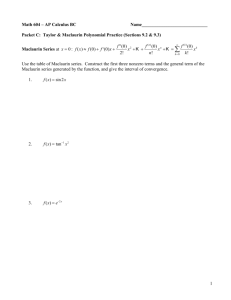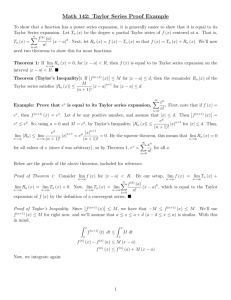Taylor and Maclaurin Series
advertisement
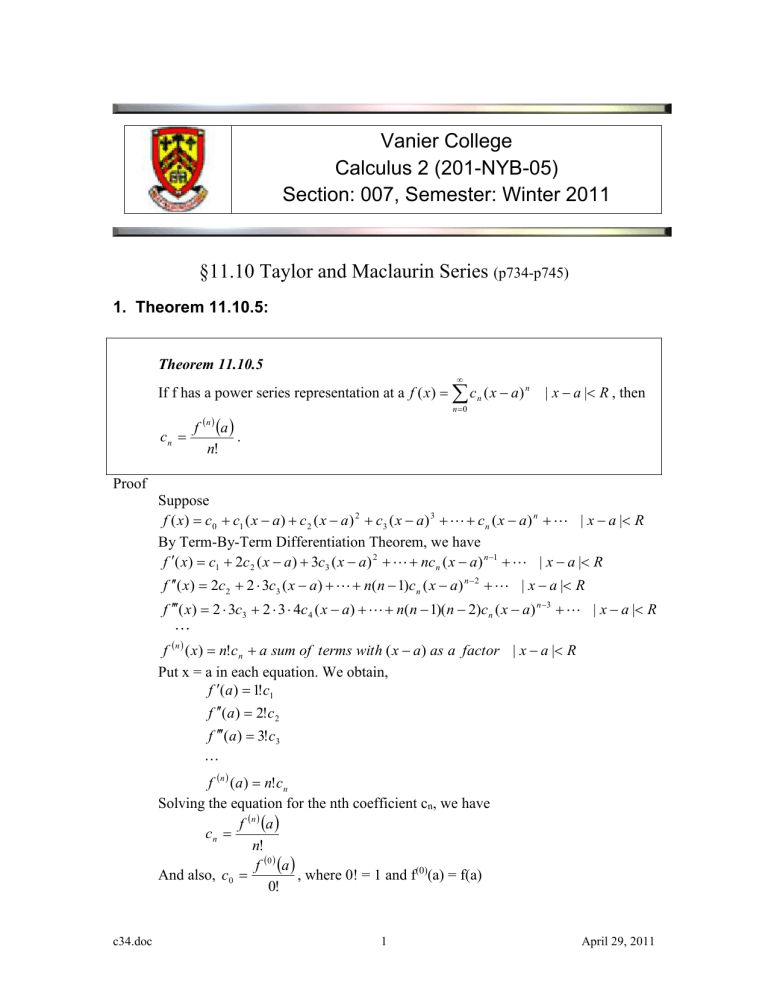
Vanier College Calculus 2 (201-NYB-05) Section: 007, Semester: Winter 2011 §11.10 Taylor and Maclaurin Series (p734-p745) 1. Theorem 11.10.5: Theorem 11.10.5 If f has a power series representation at a f ( x) c n ( x a) n | x a | R , then n 0 f n a . cn n! Proof Suppose f ( x) c0 c1 ( x a) c 2 ( x a) 2 c3 ( x a) 3 c n ( x a) n | x a | R By Term-By-Term Differentiation Theorem, we have f ( x) c1 2c 2 ( x a) 3c3 ( x a) 2 nc n ( x a) n 1 | x a | R f ( x) 2c 2 2 3c3 ( x a) n(n 1)c n ( x a) n 2 | x a | R f ( x) 2 3c3 2 3 4c 4 ( x a) n(n 1)( n 2)c n ( x a) n 3 | x a | R f n ( x) n!c n a sum of terms with ( x a) as a factor | x a | R Put x = a in each equation. We obtain, f (a ) 1!c1 f (a ) 2!c 2 f (a ) 3!c3 f n (a ) n!c n Solving the equation for the nth coefficient cn, we have f n a cn n! f 0 a And also, c0 , where 0! = 1 and f(0)(a) = f(a) 0! c34.doc 1 April 29, 2011 2. Definition of Taylor Series and Maclaurin Series: Definition 11.10.6 (p735) If f has derivatives of all orders at a, then we define the Taylor series of the function at a (or about a or centered at a) to be f n a ( x a) n n! . n 0 f (a ) f (a ) x a 2 f ( a ) ( x a ) 3 f (a) ( x a) 1! 2! 3! And the polynomial n f i a Tn ( x) ( x a) i i! i 0 f (a) f (a) f n (a) 2 x a f (a) ( x a) ( x a) n 1! 2! n! is called the nth-degree Taylor polynomial of f at a. Definition 11.10.7 (p736) For the special case a = 0 the Taylor series f n 0 n ( x) n! n 0 f (0) f (0) 2 f (0) 3 x f (0) ( x) ( x) 1! 2! 3! is called the Maclaurin series of the function f. And the polynomial n f i 0 i ( x) i! i 0 n f (0) f (0) 2 x f (0) ( x) n ( x) 1! 2! n! is called the nth-degree Maclaurin polynomial of f at a. f (0) Definition of Remainder of the Taylor Series (p737) Rn x f ( x) Tn x is called the remainder of the nth-degree Taylor polynomial of f(x) Note: We define that 0! = 1 and f (0) = f. Example 1 (p736) x Find the Maclaurin series for f ( x) e and its radius of convergence. Solution If f ( x) e x , then f n ( x) e x , so f n (0) e 0 1 for all n. c34.doc 2 April 29, 2011 Therefore, the Maclaurin series is f n 0 n xn x x2 x3 x 1 n! 1! 2 ! 3 ! n 0 n 0 n! Let an = xn /n!. Then x an1 x n1 n! n 0 1 an (n 1)! x n 1 By the Ratio Test, the series converges for all x and the radius of convergence is R = ∞. 3. Two Theorems about Taylor Series (p737) When does a Taylor series converge to its generating function? Theorem 11.10.8 f n a on | x - a | < R ( x a) n n! n 0 if and only if lim Rn ( x) 0 for | x - a | < R, where Rn x f ( x) Tn x is the f ( x) n remainder of the Taylor series Proof Suppose lim Rn ( x) 0 for | x - a | < R. n Then lim Tn ( x) lim [ f ( x) Rn ( x)] f ( x) lim Rn ( x) f ( x) for | x - a | < R. n n n Conversely, suppose f ( x) lim Tn ( x) for | x - a | < R, then we have n lim Rn ( x) lim [ f ( x) Tn ( x)] f ( x) lim Tn ( x ) = f(x) – f(x) = 0 for | x - a | < R. n n n How accurately do a function’s Taylor polynomials approximate the function on a given interval? Taylor’s Inequality Theorem 11.10.9 (p737) If | f n1 ( x) | M for | x a | d , then the remainder Rn(x) of the Taylor series satisfies the inequality M | Rn ( x) | | x a | n 1 for | x a | d (n 1) ! That inequality is called the Taylor’s inequality. Proof c34.doc To prove this is true for n = 1, that is, prove that if | f ( x) | M M then | R1 ( x) | | x a | 2 for | x a | d 2! 3 for | x a | d , April 29, 2011 Given | f ( x) | M (1) for |x – a| d Assume f ( x) M , for a x a + d, then x Thus a x a x f t dt f a M t a dt a a Then f ( x) f (a) f a x a f ( x) f (a) f a x a That is, R1 x (2) x f t dt Mdt a By FTC2, we have f t Mt , Then f x f a M x a , and f x f a M x a x a x M x a 2 , and 2 M x a 2 2 M x a 2 2 Assume f ( x) M , for a x a + d, then x x a a f t dt Mdt M Similarly, we have R1 x x a 2 2 From (1) and (2), we have By FTC2, we have | R1 ( x) | M | x a | 2 for a x a + d 2! Using similar calculations, we can show this inequality is also true for a-d x a M Therefore, we have | R1 ( x) | | x a | 2 for |x – a| d 2! 4. A Helpful Limit (p738) xn 0 n n ! for every real number x lim (11.10.10) Proof xn is converges for all x from Example 1. n 0 n! xn 0 By Theorem 11.2.6, we have lim n n ! Because the series c34.doc 4 April 29, 2011 Example 2 (p738) x Prove that e is equal to the sum of its Maclaurin series. Solution Proof Let f(x) = ex, then f(n+1)(x)= ex for all n. If d is any positive number and | x | d, then | f(n+1)(x) | = ex ed. By the Taylor’s Inequality, we have ed | Rn ( x) | | x | n 1 for | x | d where a = 0, and M = ed. (n 1) ! n 1 x ed lim | x | n 1 e d lim 0 n ( n 1) ! n ( n 1)! (Limit 11.10.10) By the Squeeze Theorem, we have lim | Rn ( x) | 0 , and therefore n lim Rn ( x) 0 for all values of x. n xn x x2 x3 By the Theorem 11.10.8, e 1 for all x. 1! 2 ! 3 ! n 0 n! x Formula 11.10.11 xn x x2 x3 ex 1 1! 2 ! 3 ! n 0 n! for every real number x Property 11.10.12 1 1 1 e 1 1! 2 ! 3 ! (11.10.12) Proof If put x = 1 in Equation 11.10.11, we obtain the expression 11.10.12. Example 3 (p739) Find the Taylor series for f(x) = e x at a = 2 Solution f (n)(2) = e2 2 f ( n ) 2 Then the Taylor series of e x is x 2n e x 2n n! n 0 n 0 n! c34.doc 5 April 29, 2011 n 1 x2 a n 1 e 2 x 2 n! 2 0 1 as n n an (n 1)! n 1 e x 2 So the Taylor series is convergent for all x and the radius of convergence is R = . Using Ratio Test, f(n+1)(x)= ex for all n. If d is any positive number and | x | d, then | f(n+1)(x) | = ex ed. By the Taylor’s Inequality, we have ed | Rn ( x) | | x 2 | n 1 for | x | d where a = 2, and M = ed. (n 1) ! n 1 x2 ed (Limit 11.10.10) lim | x 2 | n 1 e d lim 0 n ( n 1) ! n ( n 1)! By the Squeeze Theorem, we have lim | Rn ( x) | 0 , and therefore n lim Rn ( x) 0 for all values of x. n e2 x 2n for all x. n 0 n! Example 4 (p739) Find the Maclaurin series for sin x and prove that it represents sin x for all x. Solution f (x) = sin x f (0) = 0 By the Theorem 11.10.8, e x f '(x) = cos x f '(0) = 1 f "(x) = -sin x f "(0) = 0 f (3)(x) = -cos x f (3)(0) = -1 f (4) (x) = sin x f (4)(0) = 0 Since the derivatives repeat in a cycle of four, then we have the Maclaurin series: f (0) f (0) 2 f n (0) n x f (0) ( x) ( x) 1! 2! n! x3 x5 x7 x 2 n 1 n x (1) 3! 5! 7! (2n 1)! n 0 (n+1) Since f (x) is sin x or cos x, we know that | f (n+1) (x) | 1 for all x. So we take M = 1 in Taylor’s Inequality: M | x | n 1 n 1 | Rn ( x) | | x 0| (n 1) ! (n 1)! c34.doc 6 April 29, 2011 By the Limit 11.10.10 (Property 3), we have | x | n 1 lim 0 . n ( n 1)! So lim | Rn ( x) | 0 by the Squeeze Theorem n It follows that lim Rn ( x) 0 by the theorem 11.1.6 n Therefore, Formula 11.10.15 sin x x x3 x5 x7 x 2 n1 for all x (1) n 3! 5! 7! (2n 1)! n 0 Example 5 (p740) Find the Maclaurin series for cos x and prove that it represents sin x for all x. Sol. 3 5 d sin x d x x x cos x dx dx 3! 5! Term by term differentiation 2n x2 x4 x6 n x 1 2n ! 2! 4! 6! n 0 By the Term-by-term Differentiation Theorem, the differentiated series for cos x is convergent for all x, since Maclaurin series fo sin x converges for all x. Therefore, 1 Formula 11.10.16 cos x 1 2n x2 x4 x6 n x for all x 1 2n! 2! 4! 6! n 0 Example 6 (p740) Find the Maclaurin series for the function f(x) = x cos x. Sol. 2n 2 n 1 n x n x x cos x x 1 1 2n! 2n! n 0 n 0 Example 7 (p740) Represent f(x) = sin x as the sum of its Taylor series centered at π/3. 3 Sol. f (x) = sin x f (π/3) = 2 f '(x) = cos x f '(π/3) = ½ 3 f "(x) = -sin x f "( π/3) = 2 c34.doc 7 April 29, 2011 f (3)(x) = -cos x f (3)( π/3) = 1/2 This pattern repeats indefinitely. Therefore the Taylor series at π/3 is f f f n 2 3 3 3 3 f x x x 1! 3 2! 3 3! 3 3 3 1 1 1 x x x 2 2 1 ! 3 2 2 ! 3 2 3 ! 3 (n+1) (n+1) Since f (x) is sin x or cos x, we know that | f (x) | 1 for all x. So we take M = 1 in Taylor’s Inequality: M | x / 3 | n 1 | Rn ( x) | | x / 3 | n 1 (n 1) ! (n 1)! By the Limit 11.10.10, we have | x / 3 | n 1 lim 0 . n (n 1)! So lim | Rn ( x) | 0 by the Squeeze Theorem 2 n n It follows that lim Rn ( x) 0 by the theorem 11.1.6 n Therefore, this series represents sin x for all x. Example 8 (p741) Find the Maclaurin series for f ( x) 1 x k , where k is any real number Sol f ( x) 1 x k f ( x) k 1 x f (0) = 1 k 1 f ( x) k (k 1)1 x f’(0) = k k 2 f ( x) k (k 1)( k 2)1 x … f n f’’(0) = k(k-1) k 3 ( x) k (k 1) k n 11 x f’’’(0) = k(k-1)(k-2) k n f n (0) k (k 1) k n 1 Therefore the Maclaurin series of f ( x) 1 x k is k k 1 k n 1 n f n 0 n x x n! n! n 0 n 0 Using Ratio Test, a n 1 k (k 1) (k n 1) x n 1 n! n 1! an k ( k 1) k n 1x n k k n n x x x as n 1 n 1 1 n So the series converges if |x| < 1, and diverges if |x| > 1. 1 c34.doc 8 April 29, 2011 Then prove that f ( x) 1 x k is equal to the sum of its Maclaurin series. k k 1 k n 1 n x , then Let g ( x) n! n 0 Term by term Differentiation k k 1 k n 1 n 1 nx n! n 1 1 x g ( x) k k 1k n 1 nx n1 k k 1k n 1 nx n n! n! n 1 n 1 n m 1 k k 1 k ( m 1) 1n k k 1 k n 1 n (m 1) x m nx m 1! n! m 0 n 0 m n k k 1 k n 1k n k k 1 k n 1 n xn nx n! n! n 0 n 0 k k 1 k n 1 k n nx n n ! n 0 k k 1 k n 1 n k x n! n 0 kg( x) kg( x) So we have g ( x) for |x| < 1 1 x g ( x) To prove g ( x) 1 x , we need to prove g ( x)1 x k k 1 Let h( x) g ( x)1 x k h( x) k 1 x k 1 g ( x) (1 x) k g ( x) kg( x) k 1 k 1 x g ( x) (1 x) k 1 x 0 k By the Theorem 4.2.5 (p284), h( x) g ( x)1 x is a constant on (-1, 1) Then h(x) = h(0) = g(0) =1 k k 1 k n 1 n k x Therefore, 1 x n! n 0 Then Note k k 1 k n 1 n x is called the binomial series, and n! n 0 k (k 1) k n 1 is called the binomial coefficient, its traditional notation is n! k k (k 1) k n 1 n! n The series c34.doc 9 April 29, 2011 Binomial Series 11.10.17 (p742) If k is any real number and |x| < 1, then 1 x k k k 1k n 1 x n 1 kx k (k 1) x 2 k (k 1)(k 2) x 3 n! 2! 3! n 0 Example 9 (p742) Find the Maclaurin series for the function f ( x) 1 4 x and its radius of convergence.. Sol. 1 4 x 1 x 1 x 2 4 x 41 2 1 4 4 1 1 1 2 n 1 1 x 2 2 n 0 n 4 2 12 32 52 12 n 1 x n 1 1 x 12 32 x 1 2 2 4 2! n! 4 4 1 1 1 3 2 1 3 5 3 1 3 5 2n 1 n 1 x x x x 2 3 n 2 8 2!8 3!8 n!8 From 11.10.17, this series converges when |-x/4| < 1, that is |x| < 4, so the radius of convergence is R = 4. *Important Maclaurin series and their radius of convergence: 1 2 1 x x xn R=1 1 x n 0 ex n 0 xn x x 2 x3 1 n! 1! 2 ! 3 ! R= (11.9.1) (11.10.11) x3 x5 x7 x 2 n1 R= (11.10.15) (1) n 3! 5! 7! (2n 1)! n 0 2n x2 x4 x6 n x R= (11.10.16) cos x 1 1 2n! 2! 4! 6! n 0 x3 x5 x7 x 2 n1 R=1 (11.9, p732) tan 1 x x (1) n 3 5 7 (2n 1) n 0 1 x k k k 1k n 1 x n 1 kx k (k 1) x 2 k (k 1)(k 2) x 3 n! 2! 3! n 0 R=1 (11.10.17) sin x x c34.doc 10 April 29, 2011 Example 10 (p744) (1) Evaluate e x dx as an infinite series. (2) Evaluate e x dx correct to within an error of 0.001. 2 1 2 0 Sol. (1) Replacing x by –x2 in the series for ex e x2 n 0 x 2 n n! 1 x2 x4 x6 1! 2 ! 3 ! Then e x2 2n x2 x4 x6 n x dx 1 1 1! 2! 3! n! Term by term Integration Cx dx x3 x5 x7 x 2 n 1 n 1 2n 1 n! 3 1! 5 2! 7 3! This series converges for all x because the original series for e x converges for all x. 2 (2) 1 x3 x5 x7 x9 0 e dx x 3 1! 5 2! 7 3! 9 4! 0 1 1 1 1 1 3 1! 5 2! 7 3! 9 4! This is the alternating series. Using Alternating Series Estimation Theorem, notice that 1 1 b5 0.001 11 5! 1320 1 2 1 1 1 1 0.7475 Then e x dx s 4 1 3 10 42 216 0 Example 11 (p744) x e 1 x Evaluate lim x 0 x2 Sol. Using the Maclaurin series for ex, we have x x2 x3 1 1! 2! 3! 1 x x e 1 x lim lim 2 2 x 0 x 0 x x 2 1 x x 1 lim x 0 2 3! 4! 2 1 c34.doc x2 FTC 2 11 April 29, 2011 3. Multiplication and Division of Power Series (p745) Some algebraic techniques to find power series are sometimes useful. Theorem for Multiplication of Power Series: Two power series A( x) a n x n and B( x) bn x n can be multiplied to n 0 n 0 obtain A( x) B( x) C ( x) c n x n , where cn a0 bn a1bn1 an b0 the result n 0 being valid for each x within the common interval of convergence. See Murray’s Advanced Calculus, ISBN 0-07-060229-8, p230 Theorem for Division of Power Series: The power series A( x) a n x n is divided by the power n 0 series B( x) bn x n where b0 0, the quotient can be written as a power series n 0 which converges for sufficiently small |x|. See Murray’s Advanced Calculus, ISBN 0-07-060229-8, p230 Example 12 (p769) Find the first three nonzero terms in the Maclaurin series for (a) ex sin x, and (b) tan x. Sol x x2 x3 x3 x5 (a) e x sin x 1 x 1! 2 ! 3 ! 3! 5! Multiply these expressions, and collect like terms as for polynomials ( Factor 1) 1 x 12 x 2 16 x 3 3 5 1 ( Factor 2) x 16 x 120 x x x2 12 x 3 16 x 4 x x 1 6 x x2 c34.doc 3 13 x 3 1 6 4 (Product) 12 April 29, 2011 Thus e x sin x x x 2 (b) 1 3 x 3! sin x x3 x5 tan x x cos x 3! 5! x2 x4 1 2! 4! Using long division, (Divisor) 1 12 x 2 1 24 x4 x 13 x 3 152 x 5 x 16 x 3 1 120 x5 x 12 x 3 1 3 1 3 1 24 x5 x 3 301 x x 3 5 1 6 x 5 2 15 5 x (Quotient) (Dividend) 1 2 Thus tan x x x 3 x 5 3 15 Exercises 11.10 1, 3, 31, 35, c34.doc 5, 37, (p746) 7, 9, 43, 45, 15, 53, 13 17, 57, 19, 63, 21, 65, 25, 67 27, April 29, 2011

